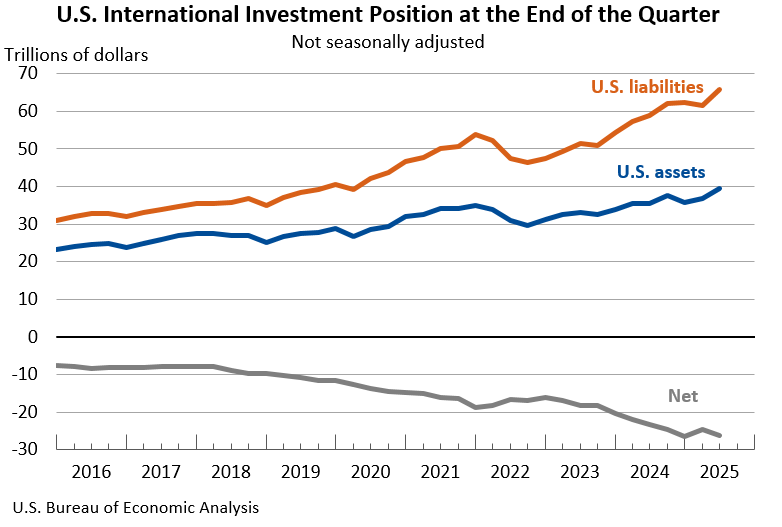Bureau of Economic Analysis
U.S. International Investment Position, 2nd Quarter 2025
The U.S. net international investment position, the difference between U.S. residents’ foreign financial assets and liabilities, was -$26.14 trillion at the end of the second quarter of 2025, according to statistics released today by the U.S. Bureau of Economic Analysis. Assets totaled $39.56 trillion, and liabilities were $65.71 trillion. At the end of the first quarter, the net investment position was -$24.65 trillion (revised).
Principal Federal Economic Indicators
Noteworthy
The Latest
Comprehensive Revisions to NIPA: Reconsidering Treatment of R&D and Entertainment
The Bureau of Economic Analysis (BEA) will release its comprehensive revision of the National Income and Product Accounts (NIPAs) next week. Among other important changes to estimates will be how the statistical agency treats research and development (R&D) and calculates entertainment in measuring gross domestic product (GDP). The revision generally occurs every 5 years.
Want to Learn More About U.S. Trade Statistics? Check out BEA's and Census' July 25 Webinar
Do you want to have a deeper understanding of how monthly trade statistics are compiled and how trade between the United States and other countries is measured? Then join the U.S. Bureau of Economic Analysis (BEA) and the U.S. Census Bureau for a July 25 webinar deciphering the U.S. international trade in goods and services report. The webinar will start at 1 p.m. EDT.
Want to Build Apps Using BEA Economic Data? BEA Launches API
Developers, are you looking for a way to bring some of the most closely watched economic data into your next app? You can now build apps using BEA economic statistics, thanks to BEA’s new application programming interface (API). The API provides direct access to gross domestic product (GDP) and related national economic statistics, along with regional economic statistics.
Revising Economic Indicators: Here's Why the Numbers Can Change
Once every 5 years, the U.S. Bureau of Economic Analysis produces a “comprehensive” revision to its gross domestic product (GDP) statistics, incorporating changes to how the U.S. economy is measured as well as more complete source data all the way back to 1929. This year is one of those years. In just a few weeks—on July 31 to be exact–updated GDP numbers will be released.
New data, new methodologies, changes in definitions and…
May 2013 Trade Gap is $45.0 Billion
The U.S. monthly international trade deficit increased in May 2013, according to the U.S. Bureau of Economic Analysis and the U.S. Census Bureau. The deficit increased from $40.1 billion in April (revised) to $45.0 billion in May as exports decreased and imports increased. The previously published April deficit was $40.3 billion. The goods deficit increased $5.0 billion from April to $63.4 billion in May; the services surplus increased $0.2…
State Personal Income: First Quarter 2013
State personal income declined an average 1.2 percent in the first quarter of 2013 after growing 2.7 percent in the fourth quarter of 2012. Personal income declines ranged from 0.1 percent in Iowa to 2.5 percent in Wyoming. In contrast, personal income grew 1.6 percent in South Dakota, the only state with an increase in the first quarter. Inflation, as measured by the national price index for personal consumption expenditures, slowed to 0.2…
State Quarterly Personal Income, 1st quarter 2012-1st quarter 2013
WASHINGTON DC, June 28, 2013 - State personal income declined an average 1.2 percent in the first quarter of 2013 after growing 2.7 percent in the fourth quarter of 2012, according to estimates released today by the U.S. Bureau of Economic Analysis. Personal income declines ranged from 0.1 percent in Iowa to 2.5 percent in Wyoming. In contrast, personal income grew 1.6 percent in South Dakota, the only state with an increase in the first…
Consumer Spending Turns Up in May
Personal income increased 0.5 percent in May after increasing 0.1 percent in April. Wages and salaries, the largest component of personal income, increased 0.3 percent in May after increasing 0.1 percent in April. Services industries’ payrolls accelerated. Good industries’ payrolls turned up.
Current-dollar disposable personal income (DPI),after-tax income, increased 0.5 percent in May after increasing 0.1 percent in April.
Personal Income and Outlays, May 2013
Personal income increased $69.4 billion, or 0.5 percent, and disposable personal income (DPI) increased $57.0 billion, or 0.5 percent, in May, according to the Bureau of Economic Analysis. Personal consumption expenditures (PCE) increased $29.0 billion, or 0.3 percent. In April, personal income increased $18.3 billion, or 0.1 percent, DPI increased $6.5 billion, or 0.1 percent, and PCE decreased $39.6 billion, or 0.3 percent, based on revised…




